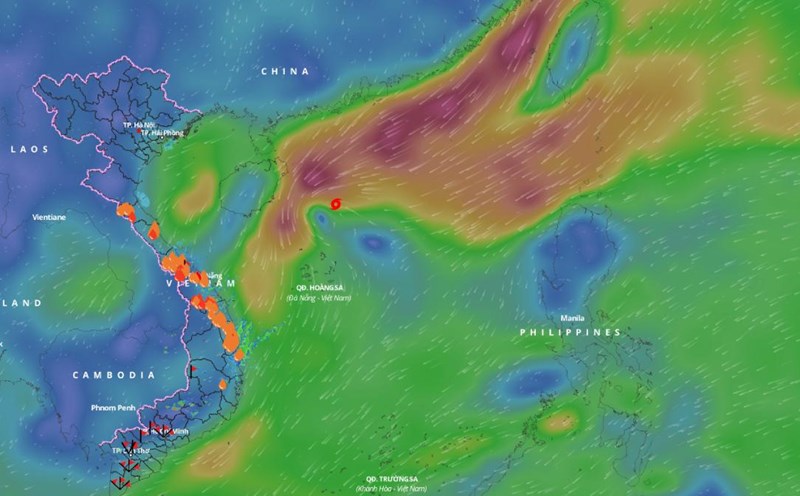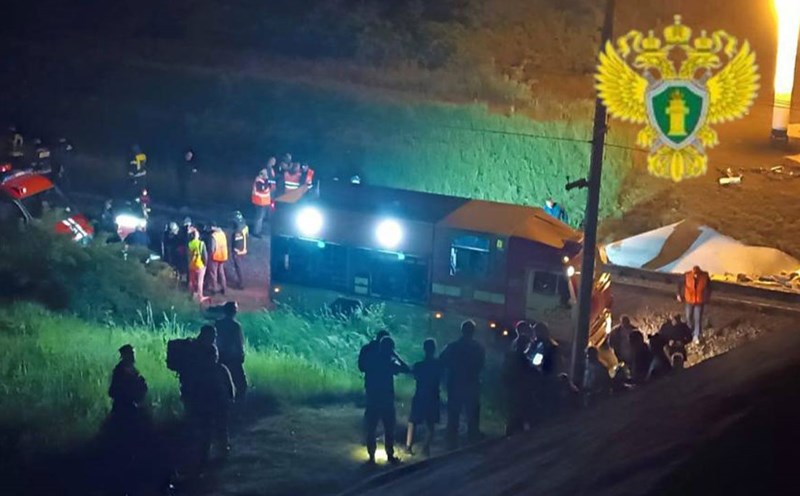
According to the update of the Department of Dyke Management and Natural Disaster Prevention (Ministry of Agriculture and Environment), from 7:00 p.m. on May 23 to 6:00 a.m. on May 24, 2025, the mountainous areas of the North and North Central regions will have rain from 40-80mm.
Some heavy rain stations such as: Cam Giang (Hai Duong) 106mm; Luc Binh (Bac Kan) 104mm; Linh Phu (Tuyen Quang) 89mm; Thinh Hung (Yen Bai) 82mm; Na Ngoi (Nghe An) 146mm; Con Cuong (Nghe An) 86mm.
Heavy rain caused 56 traffic routes in Lao Cai, Yen Bai, Tuyen Quang to be eroded with a total volume of 5,883m3; 1 temporary bridge in Y Ty commune, Bat Xat district, Lao Cai was swept away.
In order to ensure traffic safety during the rainy and stormy season, the Traffic Safety Committee recommends that drivers pay special attention to steep mountain passes and complex mixed terrain.
When drivers encounter a spillway, they need to pay attention to avoid it. Realizing the dangerous water level, people should not go. Drivers need to wait patiently for the water to recede before overcoming.
When driving through steep mountain passes, drivers need to regularly update information through the media to choose other routes to avoid landslides.
In case of encountering landslides, drivers need to go down to explore and see how much the landslide is, and how much the road can be passed. From there, decide whether to continue or stop, avoid getting stuck in a dilemma that can cause serious consequences.
On the rocky mountain roads, vehicle owners need to pay attention to the vibration of the road surface and loud noises. If you notice small piles or cracks of rocks on the road, you should pay special attention because these locations are at high risk of landslides.
The steep mountain passes during the rainy season often experience congestion. Drivers should be careful not to drive too close to the vehicle in front to avoid unexpected situations.
For flooded roads, you should drive into the middle of the lane because both sides are often low and have higher flooding levels.
Avoid getting close to heavy trucks, as water from large wheels can obscure the view, causing danger. It is also necessary to ensure the vehicle's overtaking ability, not trying to overtake on corners or with limited visibility.
In the case of curved roads and wet road surfaces, when braking suddenly, the vehicle is likely to be thrown off, lose control, and easily lead to accidents.
Drivers need to pay attention to some driving techniques such as: keeping a distance, avoiding heavy vehicles and turning on traffic lights.
turn on the lights and go on low numbers, all gas.
When it rains, vehicle owners should turn on fog lights, positioning lights or cos lights. Because in bad weather conditions, reduced visibility can easily cause accidents, turning on the lights helps vehicles in the opposite direction as well as vehicles in the same direction to easily notice.
When traveling in flooded areas, keep the engine speed (turbocharger) high and even to avoid water entering the exhaust pipe, causing the vehicle to "starve". For manual transmission vehicles, the first row should be left, while for automatic vehicles with D1, D2... switch to D1.
Note that when the water level is half a tire, that is, the limit should not be exceeded. For high-chassis vehicles, they can pass but must not let water overflow the front of the vehicle into the air vents and engines.
All loads off, calmly handle stalled vehicles
When the vehicle goes steeply, it needs a lot of traction. At this time, it is necessary to turn off all the avoiding loads such as adjustment, sound... to reduce the load on the engine.
If the vehicle accidentally stalls, it is necessary to assess the situation accurately. If there are no signs of flooding, calmly re restart the engine. In case of flooding, get out of the vehicle to a safe place and call for help, do not try to restart the vehicle to avoid the event of a waterstroke.
And finally, at least 1 rescue phone number should be saved, ensuring the correct number and that rescue center is still operating. It is best to prepare necessary rescue phone numbers in the places you pass through before the trip.







